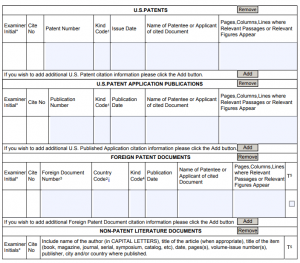When it comes to the preparation of IDS, you might take help from an Information Disclosure Statement example. Amongst 100 different things that you must oversee, IDS is a simple, yet very crucial part of your application. But, how do you prepare it and file it? Also, in case you are unaware of what IDS is, don’t worry, we have you covered.
The name, Information Disclosure Statement is quite descriptive. But, we will still provide you with a detailed description of what it is using an Information Disclosure Statement example.
Related Article: When & How to File IDS?
What is the Importance of Information Disclosure Statement?
An IDS, or Information Disclosure Statement, is a vital part of every patent application. It contains vital information about what the patent applicant already knows about the state-of-the-art.
Every patent applicant has the duty to disclose every Material of Patentability that he/she is aware of to the USPTO. This includes prior art, non-patent text, and anything else that is similar to the invention.
You can see the stipulation in MPEP 2001 and 37 CFR 1.56. Every patent applicant must satisfy this candor in order to proceed with the patent prosecution process.
What does an Information Disclosure Statement Example look like?
The USPTO provides a form for the IDS, PTO/SB/08a. This form asks you to fill out detailed information about the prior art you are aware of. It has 4 distinct tables: US Patents, US Patent Publications, Foreign Patent Documents, Non-Patent Literature Documents.
Check out the tables given below.

Fig: Information Disclosure Statement Example
You need to fill out each table in a diligent manner and leave out nothing that you are aware of.
Is Searching for Prior Art Necessary for Information Disclosure Statement?
You might ask yourself, “So should I search for prior art?” This can be a tricky question. But, the answer, in context with the IDS, is no. The USPTO requires you to disclose only the prior art that you’re aware of. So you need not conduct a search for the sole purpose of putting the results in the IDS.
However, you should always conduct a Patent search before proceeding with the filing process. You should be aware of your application is worth filing or not in the first place. You must include the results of this search in your IDS.
In conclusion, you should conduct a patent search, but not for the purpose of IDS.
What Information Should You Disclose?
Based on the information disclosure statement example, you know what information needs to be disclosed. Information that classifies as “material to patentability” is any information that might question the novelty of your invention. Also, if any information potentially deems your invention as “obvious”, even then it classifies as material to patentability.
There might be a situation where you are not sure if the information is relevant to your invention or not. In this case, it is better to be safe by including it in the IDS.
These might involve existing patents, patent applications, scientific journals, blogs, etc. Further, it can also be in the form of Office Actions, whether it’s dealing with the US or foreign patent applications.
Related Article: What are the Prior Art Documents required while filing an IDS?
Why Choose SmartIDS Solutions?
We hope that the Information Disclosure Statement example helped you understand its importance. We, at SmartIDS Solutions, are here to help you out. Timely delivery of information disclosure statements and opportune patent grant for your invention is our top priority. We provide ready to file IDS forms in USPTO prescribed format. Our team remains up-to-date with the current regulations and always comply with the rules of the USPTO.
To make an inquiry, visit the Smart IDS Solutions Services.
Related Articles:
How to Write a Patent: The Most Important Tips, Tricks, and Hacks
Patent Filing Guide: Every Step Simplified (And Common Mistakes)
